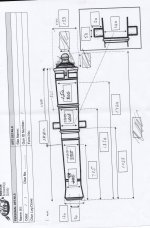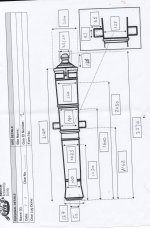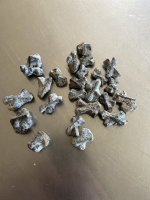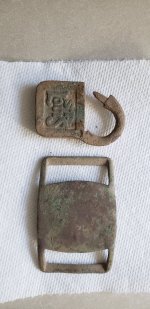Nice cannon! Sure would like to know approximate dimensions and weight. Have a target we're looking for from that age range. Thanks
You are using an out of date browser. It may not display this or other websites correctly.
You should upgrade or use an alternative browser.
You should upgrade or use an alternative browser.
Bronze cannon
- Thread starter Wobbo123
- Start date
ARC
Gold Member
- Aug 19, 2014
- 37,280
- 131,717
- Detector(s) used
- JW 8X-ML X2-VP 585
- Primary Interest:
- All Treasure Hunting
Whys that!? Had some people look and they are thinking 14th century. Nobody's been able to match the markings to anything tho.
I would agree with this assessment.
(I deleted earlier post where I stated I thought these were much older than TRG's theory due to several reasons)
Smithbrown
Bronze Member
- May 22, 2006
- 1,002
- 831
I did explain further down that the decoration is similar to that found on late 15th/ early 16th century cannon. Were you given any reason why anyone would think the guns are as early as the 14th century? were you shown pictures of other 14th century cannon to compare them too? As far as I know, I can't think of any bronze piece that dates from that early. And not that many pieces surviving from the 15th century, either. I will stick to my assessment- early 16th century, possible creeping earlier into the very end of the 15th century.
- Thread starter
- #25
The detail of the decoration - the trefoil with loops - is found on cannon dating from the late 15th up to the first decades in the 16th century. it is not restricted to a country- you find it on French, Spanish, Flemish, Portuguese guns.
Ah nice one, thats what i was here to try and find out. Two well known cannon experts.(well known to thoses that know about these things, I'd never heard of them!) have had a look at them and both agreed 15th Century but due to Covid nobody is allowed out to actually visit the guns and have a proper look. A 3d laser scan is waiting to happen...but who knows when!
They are thought to be land guns which would have been mounted on carrigages and put onto a ship.
- Thread starter
- #26
Well done Sherlock haha Wreck Diving from Newhaven, East Sussex bit more about my wreck diving in there.
I'll post up the dimesions....
I'll post up the dimesions....
- Thread starter
- #27
I think its agreed they are European,,French, Spanish, Germanic I dive South Coast UK...found them in Seaford Bay, East Sussex if you wanna Google Map it. Lot of ships have wrecked in the bay but these look as if they were thrown overboard as no evidence of a wreck
Smithbrown
Bronze Member
- May 22, 2006
- 1,002
- 831
Now I am confused- 14th or 15th century? If 15th century, you might want to go back and change the typing slip, or we will be confused!
ARC
Gold Member
- Aug 19, 2014
- 37,280
- 131,717
- Detector(s) used
- JW 8X-ML X2-VP 585
- Primary Interest:
- All Treasure Hunting
I am thinking the turn... to early 16th century... 1490-1525.
Now that is real "shot from the hip"... but I am gonna "stay". heh
PS... they are "crude" or very badly corroded... if crude... they were possibly pitched for numourous possible reasons. (one being "upgrades at sea")
OR... they have been down for a REALLY long time... the amount of corrosion IF this is the case is beyond any I have seen on a cannon.
Now that is real "shot from the hip"... but I am gonna "stay". heh
PS... they are "crude" or very badly corroded... if crude... they were possibly pitched for numourous possible reasons. (one being "upgrades at sea")
OR... they have been down for a REALLY long time... the amount of corrosion IF this is the case is beyond any I have seen on a cannon.
Last edited:
- Thread starter
- #30
Haha...ok forget i said 14th century. Below is from an email from someone who knows about these things but is only trying to identify them from pics and video. It seems most are in agreement 15th-16th. Good to know the design/pattern is a common design and not attributed to any particular maker as i thought. He mentions the porcupine in his email below but after cleaning a little more I dont think it is. Thanks for your thoughts.Now I am confused- 14th or 15th century? If 15th century, you might want to go back and change the typing slip, or we will be confused!
Gianni Ridella says:
"Coming to the two pieces you are dealing with, their encrusted and partially abraded conditions don't allow me to express a defined identification and dating that will be make easier after they will be cleaned and drawn. So I limit to formulate my first impressions. I agree with my friend Nico Brinck on the fact they appear late 15th-early 16th century products but I am not so sure they are French. Unfortunately there are none French surviving exemplars of this class (falconets or robinets?) and period with rounded surfaces but only polygonal shaped without division between reinforce and chase. Even assuming that the figure on one of them (gun 2?) is a porcupine I observe that the French pieces of this times (Luis XII's reign 1499-1515) shows well outdistanced trunnions from the mid-mouldings (see the attached figure), like in the survived heavier ones (battery cannons) while in our ones they are in contact with them. I could be wrong but I would rather think of a Central European origin (Germanic area)."
- Thread starter
- #31
I am thinking the turn... to early 16th century... 1490-1525.
Now that is real "shot from the hip"... but I am gonna "stay". heh
PS... they are "crude" or very badly corroded... if crude... they were possibly pitched for numourous possible reasons. (one being "upgrades at sea")
OR... they have been down for a REALLY long time... the amount of corrosion IF this is the case is beyond any I have seen on a cannon.
I think they would have pretty nice when new. They were in shallow water, 10m, and been battered by storms sand and shingle. Possibly thrown overboard after a battle due to damage as one has a chunk missing at the muzzle. No sign of a wreck at the site.
ARC
Gold Member
- Aug 19, 2014
- 37,280
- 131,717
- Detector(s) used
- JW 8X-ML X2-VP 585
- Primary Interest:
- All Treasure Hunting
Haha...ok forget i said 14th century. Below is from an email from someone who knows about these things but is only trying to identify them from pics and video. It seems most are in agreement 15th-16th. Good to know the design/pattern is a common design and not attributed to any particular maker as i thought. He mentions the porcupine in his email below but after cleaning a little more I dont think it is. Thanks for your thoughts.
Gianni Ridella says:
"Coming to the two pieces you are dealing with, their encrusted and partially abraded conditions don't allow me to express a defined identification and dating that will be make easier after they will be cleaned and drawn. So I limit to formulate my first impressions. I agree with my friend Nico Brinck on the fact they appear late 15th-early 16th century products but I am not so sure they are French. Unfortunately there are none French surviving exemplars of this class (falconets or robinets?) and period with rounded surfaces but only polygonal shaped without division between reinforce and chase. Even assuming that the figure on one of them (gun 2?) is a porcupine I observe that the French pieces of this times (Luis XII's reign 1499-1515) shows well outdistanced trunnions from the mid-mouldings (see the attached figure), like in the survived heavier ones (battery cannons) while in our ones they are in contact with them. I could be wrong but I would rather think of a Central European origin (Germanic area)."
Well then.
I rest my case.
- Thread starter
- #33
Nice cannon! Sure would like to know approximate dimensions and weight. Have a target we're looking for from that age range. Thanks
Hi, hopefully i've attached my measurments...theres so much stuff on this site i dunno whats what,it needs streamlining!!...anyway, these are the measurements i took when they first came out the sea. Excuse my scrawl but you should get the idea. I do have it all written out neat on a PDF but it has some personal info on it i don't wanna post. Not weighed them but took four blokes to lift them into the back of a van!!!


- Feb 3, 2009
- 37,512
- 139,067
- 🥇 Banner finds
- 1
- Detector(s) used
- Deus, Deus 2, Minelab 3030, E-Trac,
- Primary Interest:
- Relic Hunting
Hi, hopefully i've attached my measurments...theres so much stuff on this site i dunno whats what,it needs streamlining!!...anyway, these are the measurements i took when they first came out the sea. Excuse my scrawl but you should get the idea. I do have it all written out neat on a PDF but it has some personal info on it i don't wanna post. Not weighed them but took four blokes to lift them into the back of a van!!!
View attachment 1892319 View attachment 1892320 [/
QUOTE]
Thank You for the above as it give one the perspective of size.
Also welcome to TN and the wonderful discovery.
"Due to COVID-all the Flo's are in hiding"
Must make things frustrating to try to escalate the recording/findings of the 2 artifacts.
Are the in water off shore finds treated the same as on shore treasures and PAS is followed?
Smithbrown
Bronze Member
- May 22, 2006
- 1,002
- 831
Well you now have three experts all agreeing on a date late 15th- early 16th century. I have also found that decoration on Portuguese pieces of that date, as well as on French and northern Europe pieces.
Top Member Reactions
-
 2318
2318 -
 1121
1121 -
 1041
1041 -
 894
894 -
 834
834 -
 778
778 -
 750
750 -
 742
742 -
 607
607 -
 504
504 -
 492
492 -
 475
475 -
 454
454 -
 419
419 -
 396
396 -
O
393
-
 392
392 -
 385
385 -
 383
383 -
 375
375
Users who are viewing this thread
Total: 2 (members: 0, guests: 2)







